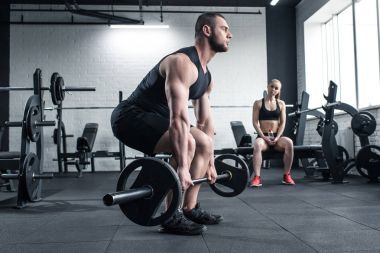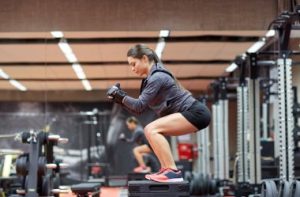
How Many Calories Do Squats Burn (4 Important Factors)
Curious about how many calories you can burn with squats? Whether you’re aiming to torch fat, build muscle, or simply improve your fitness, squats pack a serious punch when it comes to calorie burning. This classic lower-body exercise engages multiple large muscle groups, like your quads, glutes, and hamstrings, turning your body into a calorie-burning furnace. But just how many calories do squats really burn, and what factors influence the numbers? Let’s dive into the science behind squats and how this powerhouse movement can help you reach your fitness goals faster than you think.

How Many Calories Do Squats Burn
On average, squats burn about 35 to 50 calories for every 10 minutes of moderate effort, depending on factors like weight, intensity, and fitness level. For someone weighing around 155 pounds, the calorie burn increases with higher intensity and added weight resistance. The more vigorous the workout, the more calories you burn.
Factors That Influence Squat Calorie Burn
The exact number of calories burned during squats varies based on individual differences and workout intensity. Heavier individuals burn more calories because their bodies require more energy to perform each squat. Additionally, increasing squat intensity by adding weights or speeding up your pace can increase the metabolic demand, boosting your calorie burn.
When incorporating squats into your fitness routine, the type of squats you perform—whether it’s a standard squat, goblet squat, or jump squat—also matters. Weighted squats and explosive movements like jump squats raise your heart rate, further contributing to a higher calorie expenditure.
For optimal results, many people pair squats with other compound exercises, creating a high-intensity workout that maximizes fat burn and muscle engagement. In fact, many trainers recommend squats for their full-body benefits, as they not only target your lower body (glutes, quads, hamstrings) but also engage your core muscles, improving overall strength and stability.
How to Maximize Calorie Burn with Squats
To burn more calories during squats, focus on form and intensity. Adding resistance, such as using dumbbells or barbells, can significantly increase the effort required and calorie output. Another common practice is to incorporate squats into a HIIT (high-intensity interval training) session, alternating between intense bursts of squatting and short rest periods. This approach keeps your heart rate elevated, helping you burn more calories even after the workout through EPOC (excess post-exercise oxygen consumption).

Calories Burned by Squats: Key Factors
Body Weight
Calories burned during squats are significantly influenced by body weight. Heavier individuals tend to burn more calories because their bodies require more energy to perform the same movement due to the increased mass they need to move.
For example, a person weighing 120 lbs may burn approximately 4-5 calories per minute of squats, while a person weighing 180 lbs could burn around 6-7 calories per minute. This difference occurs because more force is required to lift and lower the additional body mass, leading to greater energy expenditure.
Exercise Intensity and Speed
The number of calories burned by squats depends on several key factors, including exercise intensity and speed. When squats are performed at a slow, controlled pace, the muscles are under tension for longer periods, which can enhance muscle engagement and promote strength building.
However, faster-paced squats tend to increase heart rate, enhancing cardiovascular benefits and leading to more calorie burn in a shorter time. Incorporating variations like jump squats significantly raises the intensity by adding explosive movement. This plyometric element recruits more muscle fibers, elevates heart rate, and boosts the overall calorie expenditure compared to traditional squats. These variations also engage the core and lower body more dynamically, making them an excellent addition to any high-intensity workout.
Duration and Number of Repetitions
The number of calories burned during squats is influenced by several key factors, including the duration of the exercise and the number of repetitions performed. The longer you spend performing squats and the higher the number of reps, the more calories you burn, as your muscles require energy to sustain the activity.
Additionally, the number of sets, reps, and rest periods between them play a significant role in energy expenditure. More sets and reps increase the overall workload, leading to higher calorie burn, while shorter rest periods can keep your heart rate elevated, boosting calorie consumption. Conversely, longer rest periods may allow your body to recover more fully, reducing the overall caloric impact. Ultimately, combining high-intensity squats with minimal rest can maximize the total calories burned during a workout.
Type of Squats (Bodyweight vs. Weighted)
The number of calories burned by squats depends on several key factors, with the type of squat being a significant variable. Bodyweight squats, which rely solely on the individual’s body mass for resistance, are effective for burning calories and building endurance.
However, adding weights, such as in barbell squats or goblet squats, significantly increases the calorie burn. This is because weighted squats engage more muscles, especially in the core, back, and arms, in addition to the legs. The added resistance requires more effort, elevating the heart rate and intensifying the workout, which leads to a greater caloric expenditure. In essence, while bodyweight squats are excellent for beginners or high-repetition sets, incorporating weights boosts both muscle engagement and overall intensity, resulting in higher calorie burn.
Estimates of Calories Burned During Squats
Calorie Burn for Bodyweight Squats
The number of calories burned during squats varies depending on the intensity and duration of the exercise, as well as factors like body weight, muscle mass, and fitness level. For bodyweight squats, calorie burn estimates can range from 3-5 calories per minute for light effort, such as slower, controlled movements with minimal resistance.
Moderate effort, where the pace is quicker and more muscles are engaged, can result in burning 5-8 calories per minute. High-intensity variations, such as jump squats or squats performed at a rapid pace, can increase calorie expenditure to around 8-12 calories per minute. These estimates highlight the effectiveness of squats in boosting overall energy expenditure.
Calorie Burn for Weighted Squats
The number of calories burned during squats depends on several factors, including body weight, intensity, and whether additional resistance is used. For bodyweight squats, a person can burn around 4-8 calories per minute, but adding resistance, such as weights, increases the energy expenditure significantly. Weighted squats engage more muscles and require greater exertion, leading to a higher calorie burn.
For example, moderate-weight squats (e.g., dumbbells or lighter barbells) can result in burning 6-10 calories per minute. When performing heavy squats, like barbell squats with substantial resistance, the calorie burn increases to about 10-15 calories per minute, depending on factors like the amount of weight lifted and the intensity of the workout. Adding weights not only enhances muscle engagement but also elevates the heart rate, further boosting calorie expenditure.

Calorie Burning Calculations
MET (Metabolic Equivalent of Task) for Squats
The Metabolic Equivalent of Task (MET) is a measure used to estimate the energy expenditure for various physical activities. It represents the ratio of the work metabolic rate to the resting metabolic rate, where 1 MET is the energy expended at rest. When calculating the calories burned during exercises like squats, the MET value helps quantify the energy cost based on the intensity of the exercise.
Squats typically have a MET of around 5 for bodyweight squats, and it increases when additional weight is used. The formula to calculate the calories burned per minute is:
Formula: Calories burned per minute = MET × body weight (in kg) × 3.5 ÷ 200.
For example, a 70 kg person performing bodyweight squats at a MET of 5 would burn approximately:
70 X 3.5 /200 = 6.13 { calories per minute}
This calculation helps individuals estimate their energy expenditure during squats, aiding in fitness and weight management planning.
Ways to Increase Calorie Burn with Squats
Incorporating Compound Movements
Incorporating compound movements into your squat routine, such as combining squats with exercises like shoulder presses or bicep curls, is an effective way to increase calorie burn. By engaging both the upper and lower body muscles simultaneously, these compound exercises demand more energy from the body, thus boosting the overall caloric expenditure.
When you perform a squat with a shoulder press, for instance, you’re not only working your legs and glutes but also activating your shoulders, arms, and core. This increased muscle recruitment requires more oxygen and energy, leading to a higher heart rate and an enhanced metabolic response. This multi-muscle engagement maximizes the efficiency of your workout, allowing you to burn more calories in less time compared to isolated movements.
Using Interval Training or Circuit Workouts
Incorporating squats into high-intensity interval training (HIIT) or circuit workouts is an excellent way to boost calorie burn both during and after exercise. HIIT alternates between short bursts of intense activity and brief rest periods, elevating your heart rate and maximizing energy expenditure.
This intense effort pushes your body into the anaerobic zone, causing it to burn more calories during the workout and continue burning calories even after it ends, a phenomenon known as the “afterburn effect” or excess post-exercise oxygen consumption (EPOC). Circuit training, which involves moving quickly from one exercise to the next with minimal rest, maintains a higher heart rate throughout the session, increasing overall calorie burn.
For example, a circuit could include squats paired with other dynamic exercises such as lunges, burpees, and push-ups. A sample routine might look like this: perform 20 squats, 15 lunges per leg, 10 burpees, and 15 push-ups, repeating the circuit for several rounds. This combination targets multiple muscle groups, elevates your heart rate, and engages both strength and cardiovascular systems, enhancing overall calorie burn.
Adding Plyometric Variations
To enhance calorie burn during squats, incorporating plyometric variations can significantly elevate the intensity of your workout. By adding explosive movements such as jump squats or squat jumps onto a box, you introduce a high-intensity element that not only challenges your muscles more but also boosts your cardiovascular system.
These plyometric exercises require rapid, powerful muscle contractions, which increase heart rate and elevate calorie expenditure compared to traditional squats. This added intensity helps to improve overall cardiovascular fitness and accelerates metabolism, leading to a more effective workout and greater calorie burn.

Additional Factors Affecting Calorie Burn During Squats
Rest Periods Between Sets
Rest periods between sets play a significant role in influencing calorie burn during squats. Shortening rest intervals can heighten the intensity of the workout, which not only enhances muscle engagement but also increases overall calorie expenditure. When rest periods are kept short, the body remains in a heightened state of exertion, leading to a greater caloric burn both during and after the exercise due to elevated metabolic demands.
In contrast, traditional strength training often incorporates longer rest periods, allowing for more complete recovery between sets, which can reduce the overall intensity and calorie burn. Circuit and HIIT (High-Intensity Interval Training) formats, on the other hand, typically feature minimal rest between exercises, leading to a more continuous and intense workout.
This approach maximizes calorie burn and boosts cardiovascular conditioning by keeping the heart rate elevated throughout the session. Thus, while traditional strength training focuses on building strength with longer rest, circuit and HIIT training emphasize a higher calorie burn through reduced rest periods and sustained high intensity.
Experience Level
Experience level plays a significant role in determining calorie burn during squats. Beginners typically use lighter weights and may not perform as many repetitions or sets, resulting in a lower overall calorie expenditure. In contrast, advanced exercisers, who have developed greater strength and endurance, are capable of lifting heavier weights and performing more repetitions. This increased intensity and volume lead to higher energy expenditure during the exercise.
Additionally, advanced exercisers often have better technique and can engage more muscle groups efficiently, further enhancing calorie burn. As such, the experience level not only influences the intensity of the workout but also the effectiveness of calorie burning during squats.
How Squats Affect Metabolism and Fat Burning
Post-Exercise Calorie Burn (EPOC – Excess Post-Exercise Oxygen Consumption)
Squats significantly impact metabolism and fat burning through a phenomenon known as Excess Post-Exercise Oxygen Consumption (EPOC). EPOC refers to the increased rate of oxygen intake following strenuous exercise, which helps restore the body to its resting state and repair muscle tissues. High-intensity squatting, which engages multiple large muscle groups simultaneously, elevates the heart rate and energy expenditure during the workout.
This heightened demand on the body results in a substantial afterburn effect, where calorie burn continues long after the exercise session has ended. The intensity and duration of squats, especially when performed with added resistance or at a high volume, can lead to a prolonged EPOC, thereby enhancing overall calorie expenditure and supporting fat loss.
Building Muscle to Boost Basal Metabolic Rate (BMR)
Squats are a powerful exercise for enhancing metabolism and promoting fat burning, largely due to their impact on muscle development. When you perform squats, you engage large muscle groups, including the quadriceps, hamstrings, and glutes. This intense muscle engagement stimulates muscle growth, which in turn boosts your Basal Metabolic Rate (BMR)—the rate at which your body burns calories at rest.
Building muscle through exercises like squats increases the overall mass of lean tissue in your body, and muscle tissue burns more calories at rest compared to fat tissue. Consequently, as you build more muscle, your body requires more energy, even when you’re not active. Over time, this leads to an increased resting calorie burn and a more efficient metabolism. Additionally, the muscle gained through regular squatting contributes to long-term fat burning, as the elevated metabolic rate helps you maintain a healthier body composition and supports ongoing improvements in metabolic function.
FAQs: How Many Calories Do Squats Burn
Q1. How many calories can I burn doing squats?
A. The number of calories burned during squats depends on factors like body weight, intensity, duration, and fitness level. On average, a person weighing 155 pounds might burn around 230-250 calories per 30 minutes of moderate squats. Heavier individuals burn more, while lighter individuals burn fewer calories.
Q2. Do squats burn more calories than other exercises?
A. Squats are effective for calorie burning because they engage multiple large muscle groups (legs, glutes, core), which raises your heart rate. While squats burn calories, high-intensity exercises like running or jumping rope tend to burn more in the same time frame. However, squats build muscle, which can enhance long-term fat burning.
Q3. How does body weight impact the number of calories burned doing squats?
A. Body weight plays a significant role in determining how many calories you burn. Heavier individuals typically burn more calories per squat because it requires more energy to move their body mass. For instance, a person weighing 200 pounds will burn more calories than someone weighing 130 pounds, even if they perform the same number of squats at the same intensity.
Q4. Does squat intensity affect calorie burn?
A. Yes! The intensity of your squat workout—whether it’s the speed, the depth of your squats, or the added weight (like dumbbells or barbells)—greatly impacts how many calories you burn. Higher intensity squats, such as jumping squats or weighted squats, will burn significantly more calories than bodyweight squats performed at a slower pace.
Q5. How can I increase the calorie burn during squats?
A. To burn more calories with squats, consider adding weight (such as holding a dumbbell), increasing the number of repetitions or sets, or incorporating variations like jump squats or sumo squats. You can also reduce rest periods between sets to keep your heart rate elevated, which will increase overall calorie burn.
Q6. Can squats help with weight loss?
A. Yes, squats can contribute to weight loss by burning calories and building muscle, which increases your resting metabolic rate. However, for significant fat loss, squats should be part of a broader exercise routine, including cardio and strength training, along with a healthy diet.
Q7. How long should I do squats to burn a significant number of calories?
A. To burn a noticeable amount of calories, aim for at least 20-30 minutes of squats or include squats in a high-intensity interval training (HIIT) session. The key is consistency—performing squats regularly, paired with other physical activities, will yield better calorie-burning results over time.
Q8. Do squats burn calories even after the workout?
A. Yes! Squats, especially when performed with added weight, stimulate muscle growth. The more muscle mass you have, the more calories you burn at rest. This post-exercise calorie burn, often called the “afterburn effect,” can continue for several hours after your workout as your body works to repair muscles and restore energy levels.
Q9. Do different squat variations burn different amounts of calories?
A. Yes, different squat variations can affect calorie burn. For example, jump squats or burpee squats, which include more dynamic movements, tend to burn more calories than standard squats. Adding resistance, such as holding weights during goblet squats, can also increase calorie expenditure.
Q10. Are squats alone enough for calorie burning and fat loss?
A. While squats are great for burning calories and building muscle, relying solely on squats for fat loss may not be enough. For optimal results, incorporate squats into a comprehensive workout plan that includes cardiovascular exercise, other strength-training moves, and a balanced diet for overall calorie burning and fat reduction.
Conclusion
Squats are a highly effective exercise for burning calories, improving strength, and enhancing overall fitness. The number of calories burned during squats varies based on factors such as body weight, intensity, and the duration of the exercise. On average, a person weighing around 155 pounds can burn approximately 223 calories during 30 minutes of squats, while someone weighing 185 pounds may burn around 266 calories in the same amount of time. Incorporating squats into a regular fitness routine not only contributes to calorie expenditure but also strengthens key muscle groups, improves mobility, and supports long-term health goals.